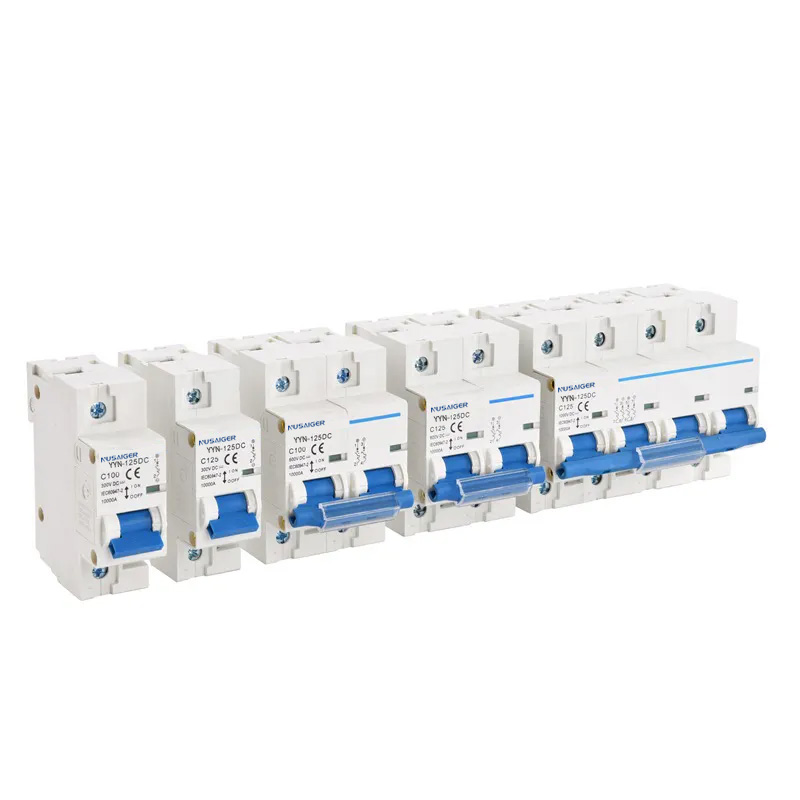Advanced Applications, Types, and Selection Guide for Miniature Circuit Breakers (MCBs)
1. Introduction
Miniature Circuit Breakers (MCBs) are crucial for modern electrical distribution systems, offering protection against overloads, short circuits, and electrical faults. As electrical systems become more complex, understanding MCB types, advanced applications, and proper selection methods becomes increasingly important.
2. Advanced MCB Applications
Beyond basic residential and commercial use, MCBs are applied in various advanced scenarios:
- Renewable Energy Systems: Protecting solar PV arrays, wind turbines, and hybrid energy systems from overcurrent conditions.
- Electric Vehicle Charging Stations: MCBs manage high inrush currents and ensure safe operation during fast charging.
- Industrial Automation: MCBs safeguard robotic arms, conveyor systems, and PLC-controlled equipment.
- Smart Buildings: Integration with IoT-enabled panels for energy monitoring and remote trip notifications.
- Data Centers: Protecting sensitive equipment and ensuring uptime by combining MCBs with surge and residual current devices.
3. Classification of MCBs
MCBs are categorized based on tripping characteristics, number of poles, rated current, and breaking capacity.
3.1 Tripping Curve Types
- Type B: Trips at 3–5 times rated current. Ideal for lighting and general-purpose circuits.
- Type C: Trips at 5–10 times rated current. Suitable for small motors and inductive loads.
- Type D: Trips at 10–20 times rated current. Designed for heavy industrial equipment with high inrush currents.
- Type K: Specifically for high inrush current loads with moderate surge.
- Type Z: Provides fast tripping for sensitive equipment with low tolerance to overcurrent.
3.2 Number of Poles
- Single-Pole (1P): Protects one live conductor, common in residential lighting circuits.
- Double-Pole (2P): Protects live and neutral, often used in small commercial installations.
- Three-Pole (3P) & Four-Pole (4P): Used in industrial three-phase systems.
3.3 Rated Current and Voltage
Choosing MCBs with proper rated current and voltage is crucial:
- Rated Current (In): Matches the expected load of the circuit.
- Rated Voltage: Must comply with system voltage, either AC or DC.
- DC MCBs require special design due to arc interruption challenges.
- High short-circuit breaking capacity ensures protection in heavy-duty applications.
4. Selection Guide for MCBs
Selecting the appropriate MCB ensures safety, compliance, and operational efficiency:
- Assess Load Characteristics: Determine total and peak current, type of load, and inrush current requirements.
- Choose Tripping Curve: Match Type B, C, D, K, or Z with load profile.
- Determine Number of Poles: Based on single-phase or three-phase system requirements.
- Check Voltage Rating: Ensure compatibility with AC or DC systems.
- Verify Breaking Capacity: Choose MCBs that can safely interrupt potential short-circuit currents.
- Environmental Considerations: Factor in temperature, humidity, dust, and vibration.
5. Advanced Features in Modern MCBs
Technological advancements have enhanced MCB functionality:
- Smart monitoring with IoT integration.
- Hybrid protection combining overcurrent and residual current detection.
- Remote trip and reset functionality for energy management.
- Compact, modular design suitable for high-density panels.
- Enhanced durability and thermal resistance for industrial use.
6. Installation Best Practices
- Ensure main power is isolated before installation.
- Mount MCB securely on DIN rails with proper alignment.
- Use appropriate wire gauge and tighten terminals to manufacturer specifications.
- Maintain clear labeling for all circuits.
- Verify functionality with test tripping before energizing circuits.
- Ensure proper spacing for ventilation and future maintenance.
7. Maintenance Strategies
Regular maintenance ensures longevity and reliability:
- Visual inspection for cracks, discoloration, or physical damage.
- Check tightness of terminals and torque if necessary.
- Functional testing by manually tripping and resetting MCBs.
- Monitor temperature and environmental conditions for derating needs.
- Keep maintenance logs for auditing and compliance.
8. Troubleshooting Common Issues
- Frequent trips: Investigate overload, short circuits, or incorrect breaker type.
- MCB fails to trip: Internal mechanical failure; replacement required.
- Overheating or buzzing: Loose connections or wrong wire size; tighten and check load.
- Residual current issues: Inspect grounding and leakage paths.
- Environmental degradation: Consider sealed enclosures for dust or moisture.
9. Case Studies
Case 1: Solar PV system overcurrent protection improved using DC-rated MCBs.
Case 2: Office building lighting circuits upgraded to Type C MCBs to handle moderate inrush currents.
Case 3: Industrial plant replaced Type B with Type D MCBs for motor protection, preventing frequent tripping.
10. Safety Standards and Compliance
Compliance ensures legal and technical reliability:
- IEC 60898: Standard for residential and commercial MCBs.
- UL 489: Covers North American applications.
- EN 60947: Industrial MCBs for enhanced safety.
- Local electrical codes must always be followed.
11. Smart MCB Trends
Smart MCBs are becoming increasingly common in modern systems:
- Remote monitoring of load and trip events.
- Integration with energy management systems for predictive maintenance.
- Automated alerts for overload and fault detection.
- Compact, modular panels for scalable installations.
- Enhanced environmental resistance for extreme industrial conditions.
12. Conclusion
Understanding the types, advanced applications, and selection criteria of MCBs is essential for electrical safety and efficiency. Proper installation, maintenance, and integration with modern smart systems ensures reliable performance across residential, commercial, and industrial settings. By adhering to international standards and best practices, MCBs provide effective protection against overcurrent, short circuits, and electrical faults while supporting evolving technological needs.



